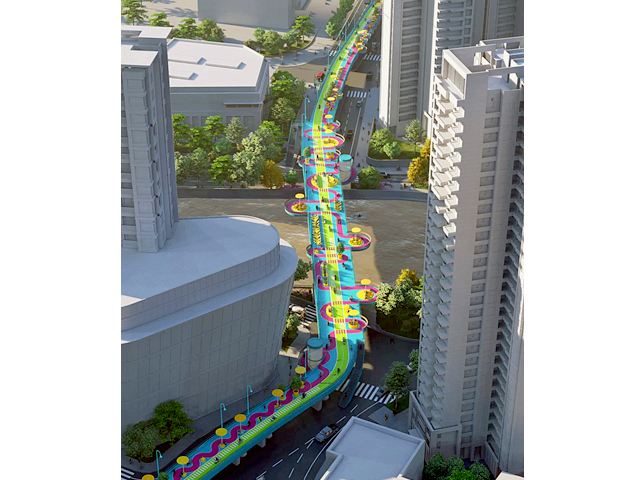OVER THE RAINBOW
29 Jul 2020
100architects has rejuvenated the iconic Puji Road pedestrian bridge in Shanghai, China, with bright colours and bold shapes, transforming it into an eye-catching promenade.

The iconic bridge was built over the Suzhou creek in 1997, connecting the Jing’an and Zhabei District. In 2009, it was renovated to allow additional access to small vehicles, such bikes and scooters, improving the urban connectivity.
The bridge extends over a kilometre in length as an elevated platform offering striking views from one of the most representative areas of the city. However, it was overshadowed when compared to other bridges, with its potential to become a local landmark diminished, Therefore, 100architects proposed to transform the bridge into an eventful elevated park crossing the city, allowing passersby to experience a unique journey through one of the densest areas of shanghai. 
The design strategy of High Loop organises the different circulations by colours, creating a hierarchy of different rhythms and paces in which the bridge can be transited. While a straight lane in electric lime defines the fast track for bicycles and motorbikes, a winding path in vibrant magenta was purposely introduced to slow down the pedestrian circulation. A contrasting loop that encourages pedestrians to take it slow, enjoy the journey and the views over Shanghai’s urban landscape and the Suzhou Creek.
As a background colour, a soothing cyan blue defines the spaces where one can stop and stay, meet with others and socialise. Viewing decks, picnic plazas, lounge areas and mini amphitheatres are located in the cyan blue pockets where contrasting yellow urban furniture are placed. New greenery planters are introduced either as decorative elements or as functional separators of the motored track and the pedestrian path. 
Besides those functions, some of the cyan blue patches have been purposely left empty in order to leave flexible areas, allowing the occurrence of informal popup night markets and other vendors. The new design does not change the current structure, but rather transforms it by only adding a colourful painted scape and functional urban objects on top. In this way, both the circulation system and the functionality of the bridge are improved.
Via designboom | Images courtesy of 100architects







